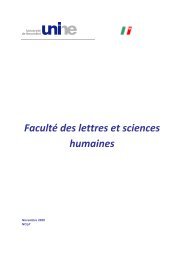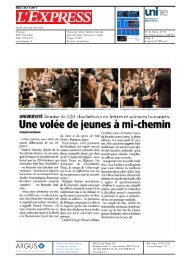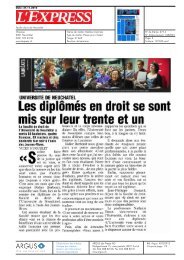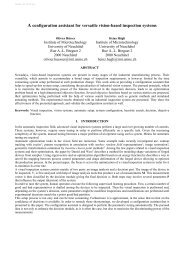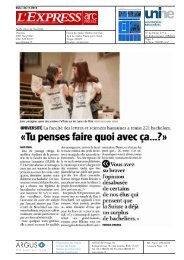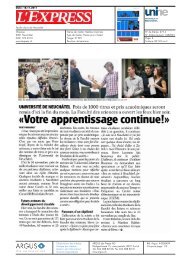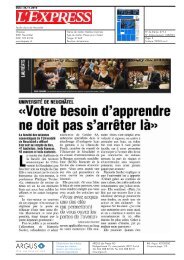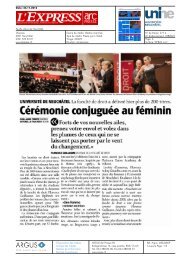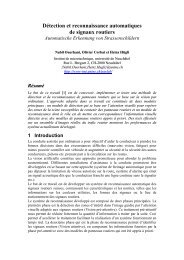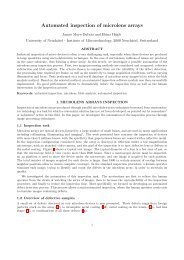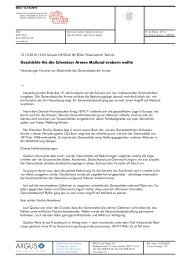Continuous Wavelet Transform on the Hyperboloid - Université de ...
Continuous Wavelet Transform on the Hyperboloid - Université de ...
Continuous Wavelet Transform on the Hyperboloid - Université de ...
You also want an ePaper? Increase the reach of your titles
YUMPU automatically turns print PDFs into web optimized ePapers that Google loves.
local and multiresoluti<strong>on</strong> nature, which provi<strong>de</strong> <strong>the</strong> interesting properties of<br />
a ma<strong>the</strong>matical microscope. Its <strong>the</strong>ory is well known in <strong>the</strong> case of <strong>the</strong> line or<br />
o<strong>the</strong>r higher dimensi<strong>on</strong>al Eucli<strong>de</strong>an spaces [Antoine et al., 2005, Mallat, 1998]<br />
and <strong>the</strong> wavelet transform has certainly become a standard in data analysis.<br />
However, data analysis has un<strong>de</strong>rg<strong>on</strong>e <strong>de</strong>ep changes recently and <strong>the</strong> field faces<br />
new exciting challenges. On <strong>on</strong>e hand <strong>the</strong> volume of data is exploding due to<br />
<strong>the</strong> ubiquity of digital sensors (just think of digital cameras). The first challenge<br />
resi<strong>de</strong>s in extracting informati<strong>on</strong> from very high dimensi<strong>on</strong>al data. On<br />
<strong>the</strong> o<strong>the</strong>r hand, <strong>the</strong> type of data has also evolved tremendously over <strong>the</strong> past<br />
few <strong>de</strong>ca<strong>de</strong>, from images or volumetric data to n<strong>on</strong>-scalar valued signals. One<br />
can cite for example tensor diffusi<strong>on</strong> imaging, a new modality in medical imaging<br />
[Hagmann et al., 2003], or multimodal signals, i.e signals obtained when<br />
<strong>the</strong> same physical scene is observed through different sensors. Finally, <strong>the</strong>re<br />
are instances where data are collected <strong>on</strong> a surface, or more generally a manifold,<br />
or through a complicated interface (think of <strong>the</strong> human eye for example).<br />
This is often <strong>the</strong> case in astrophysics and cosmology [Martinez-G<strong>on</strong>zalez et al.,<br />
2002, Cay<strong>on</strong> et al., 2003], geophysics but also in neurosciences [Angenent et al.,<br />
1999], computati<strong>on</strong>al chemistry [Max and Getzoff, 1988] ... The list is truly<br />
endless. The sec<strong>on</strong>d challenge thus resi<strong>de</strong>s in <strong>the</strong> complexity of data sources<br />
and a field <strong>on</strong>e could call Complex Data Processing might be emerging.<br />
A given feature shared by all <strong>the</strong>se problems is <strong>the</strong> importance of geometry :<br />
ei<strong>the</strong>r important informati<strong>on</strong> is localized around highly structured submanifolds,<br />
or data types obey intrinsic n<strong>on</strong>linear c<strong>on</strong>straints. As a c<strong>on</strong>sequence of<br />
<strong>the</strong> challenges in complex data processing, <strong>the</strong> representati<strong>on</strong> and analysis of<br />
signals in n<strong>on</strong>-Eucli<strong>de</strong>an geometry is now a recurrent problem in many scientific<br />
domains. Because of <strong>the</strong>se <strong>de</strong>mands, spherical wavelets [Antoine and<br />
Van<strong>de</strong>rgheynst, 1999] were recently <strong>de</strong>veloped and applied in various fields,<br />
from Cosmology [McEwen et al., 2004] to Computer Visi<strong>on</strong> [Tosic et al., 2005].<br />
Although <strong>the</strong> sphere is a manifold most <strong>de</strong>sirable for applicati<strong>on</strong>s, <strong>the</strong> ma<strong>the</strong>maticalanalysisma<strong>de</strong>sofarinvitesusto<br />
c<strong>on</strong>si<strong>de</strong>r o<strong>the</strong>r manifolds with similar<br />
geometrical properties, and first of all, o<strong>the</strong>r Riemannian symmetric spaces of<br />
c<strong>on</strong>stant curvature. Am<strong>on</strong>g <strong>the</strong>m, <strong>the</strong> two-sheeted hyperboloid H 2 stands as a<br />
very interesting case. For instance, such a manifold may be viewed as <strong>the</strong> phase<br />
space for <strong>the</strong> moti<strong>on</strong> of a free particle in 1+1-anti <strong>de</strong> Sitter spacetime [Gazeau<br />
et al., 1989, Gazeau and Hussin, 1992]. O<strong>the</strong>r examples come from physical<br />
systems c<strong>on</strong>strained <strong>on</strong> a hyperbolic manifold, for instance, an open expanding<br />
mo<strong>de</strong>l of <strong>the</strong> universe. A completely different example of applicati<strong>on</strong> is<br />
provi<strong>de</strong>d by <strong>the</strong> emerging field of catadioptric image processing [Makadia and<br />
Daniilidis, 2003, Daniilidis et al., 2002]. In this case, a normal (flat) sensor is<br />
overlooking a curved mirror in or<strong>de</strong>r to obtain an omnidirecti<strong>on</strong>al picture of<br />
<strong>the</strong> physical scene. An efficient system is obtained using a hyperbolic mirror,<br />
since it has a single effective viewpoint. Finally, from a purely c<strong>on</strong>ceptual point<br />
of view, having already built <strong>the</strong> CWT for data analysis in Eucli<strong>de</strong>an spaces<br />
2




